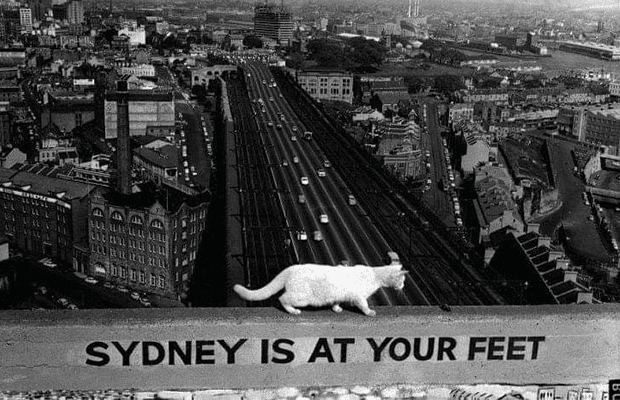The Harbour Bridge; a Sydney landmark, a feat of engineering, a conduit between two sides of the city. And, at one point during the 1950’s, a home to a litter of white cats.
Living amongst sandstone and steel, this group of enigmatic felines found their home in the Bridge’s infamous pylons. They spent their days slinking across the Sydney skyline, their white fur a stark contrast to the Bridge’s sooty colouring. But just how did the Harbour Bridge end up with a litter of kittens?
The story begins in 1948, with a quiet, determined young woman named Yvonne Rentoul. Having recently returned from the war, Rentoul was fed up with what she viewed as a lack of tourist opportunities in Sydney. She dreamed of something more. She dreamed of an Australian exhibition, a space which would educate tourists about Australian history and wildlife. And as for the location of this exhibition, Rentoul desired none other than the Harbour Bridge pylons, thinking it was outrageous that they could be left vacant.
However, the pylons’ vacancy was a relatively new phenomenon. Previously, they were leased by Archer Whitfield, who operated a museum and funhouse within them. Attractions included a cafe, Aboriginal museum, photographic gallery, telescopes, a Buddhist temple (which bizarrely occupied one of the pylon rooms), and a printing room, in which he produced a regular newspaper. Nonetheless, after World War 2 broke out, Whitfield’s lease was terminated, and the Australian Military Forces took over all four pylons. They had remained vacant ever since.
Yvonne Rentoul, realising this wasted opportunity, managed to convince the Department of Main Roads (now the Department of Roads and Maritime Services), to lease her the (now empty) southeast pylon. In December that year, she opened the Pylon lookout. The exhibition’s contents were not too dissimilar to its predecessor’s, filled with maps, souvenirs, and dioramas. Notably though, Rentoul also brought a collection of cats.
Initially, there were three: George, who was often photographed lingering near the binoculars, and the twins, Bridget and Plylon. However as time passed, these numbers soon multiplied. In the end, it is believed that more than 60 cats came to call the southeast pylon of the Harbour Bridge home during Rentoul’s two decade tenancy.
Shortly after the museum opened, tourists began to catch on to this feline phenomenon. After all, bone-white cats strutting along the Sydney skyline could hardly go unnoticed. Indeed, by the mid 1950’s and 60’s, the kittens became a much loved tourist attraction. Sydneysiders and foreigners alike flocked to Rentoul’s Australian museum to see these mystical new residents. One 1960s tourism brochure advertises these “world famous white cats”, describing them as “a joy for the kiddies and a delight for the adults.”
With the clowder’s growing stardom, the pylon’s infrastructure needed some urgent adjustments. A cattery was installed on the roof, providing the litter with nocturnal security. Rumour has it that on this level, the cats also had access to a fishpond. On the parapet level, just 14 steps down from this penthouse sanctuary, the colony’s luxurious existence continued. Here, the cats enjoyed an outdoor garden and custom-built merry go round, allowing them to truly live the high life.
However, like any hedonistic adventurer searching for pleasure in the harbour city, the kittens’ lavish lifestyle was short-lived. Sydney was changing. The arrival of the 1970s meant that the city was becoming more sophisticated and the idea of having a cultural landmark such as the Harbour Bridge ruled by a litter of cats became highly undesirable. Rentoul’s feline escapade, once a celebrated novelty, was now considered tacky; an unknown writer from the Sydney Morning Herald described it as “outdated”, “amateurish” and “haphazard”.
Unsurprisingly, when Rentoul’s lease ended in 1971, it was not renewed. Heartbroken at its closure, and outraged that her exhibition was deemed second rate, she was forced to leave the pylon. She took the remaining cats with her and resolved to never return. For the next 10 years the structure remained closed to the public — the once famous Harbour Bridge cattery, exhibition, and cafe now nothing more than a sandstone shell.
Today, the South-East pylon has found a new tenant. BridgeClimb Sydney is the pylon’s proud new occupier, the group also providing services allowing groups to scale the bridge’s steel arches. The pylon continues to attract thousands of visitors, both from Sydney and around the globe. Inside, the museum has been modernised. Lined with glass panels, its contents document the construction and history of this Sydney icon. But, in these upgrades, one can’t help but mourn how the charm of Rentoul’s handmade passion project has been lost, reflecting how, in our pursuit to sanitise urban landscapes, local cultures are inevitably crushed.





